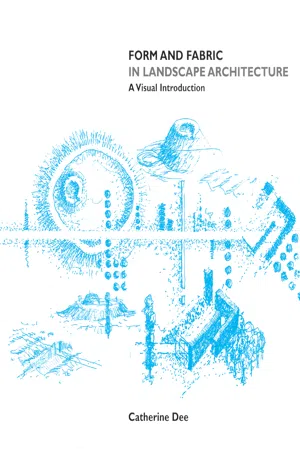![]()
1 Landscape Fabric
‘Landscape fabric’ has been chosen as a term to represent whole and integrated landscapes at various scales. ‘Fabric’ is used because it suggests interconnected wholes made of parts which are created through process. It also suggests cohesion and robustness, which are considered to be positive qualities of designed landscapes.
The ‘fabric’ section of this book has two main purposes. First, it aims to introduce some of the broader physical, environmental and social contexts in which the design of places by professional landscape architects takes place.
In the second part, the fabric of individual places at ‘design scales’ is explored. The purpose is to identify qualities considered desirable in designed places and also to illustrate how spaces, paths, edges, foci and thresholds make up the ‘fabric’ of landscapes. In addition, the illustration of ‘whole’ places aims to reinforce the concept that integration of landform, vegetation, structures and water is paramount in design.
Contexts for the Design of Landscapes
The following pages summarise some important contexts for landscape architecture. These include physical contexts such as the natural environmental context for design, as well as social and cultural contexts.
Global Landscape
The design of local landscapes should always be considered in the context of the global environment. This is of particular importance in relation to sustainability and the need to protect natural places, systems and resources. Landscapes are part of natural systems which support life. Design can contribute to or detract from these systems. Choices in design affect the global landscape. For example, energy can be conserved by improving microclimates through design or by using local building materials to avoid transportation. Biodiversity can be increased or reduced.
Landscape Processes and Systems
It is essential for designers to have an understanding of the natural processes that make and influence the landscape. It is also important to understand how people have changed and continue to alter landscapes through agriculture, industry and settlement. Landscape architecture modifies or harnesses natural processes (for example, the growth of plants, rainfall) for human purposes through construction and management. The aims of design are often to conserve, protect or enhance natural environments or to regenerate natural systems in places which have been contaminated or laid waste. The primary natural systems and elements that form the context for, and may be altered in, landscape design are briefly:
All of these aspects need to be surveyed and evaluated before landscapes can be changed in design. The ‘natural’ elements of water, topography and vegetation are the ‘material’ of design along with processed substances.
Landscapes and People
Landscapes are for people. The design of landscape takes place in the context of people’s cultural, social, political, economic and environmental needs. Landscape design is considered to be a holistic activity which attempts to integrate concerns for all of these human aspects. This book seeks to link morphology of landscape to human experience and use, but it does this within particular social, cultural and environmental contexts. The physical and social contexts illustrated are primarily relatively affluent (in global terms), northern, temperate urban landscapes. Some ideas, principles and assertions have broader relevance to the design of landscapes beyond this context. Others are specific to this context.
Regional Landscapes
Natural and semi-natural systems, agriculture, settlement, transport, climate and culture affect the form and fabric of regional landscapes. Landscape and environmental planning of regions is beyond the scope of this book but designed landscapes should always be considered in a regional context. Many regions have positive economic, social, cultural and environmental functions into which new designed landscape should ‘fit’ or enhance and contribute to. Other regional landscapes may be degraded economically, socially, environmentally or aesthetically. In these contexts, landscape design contributes to and is carried out within the context of a broader economic, social and environmental strategy for a region’s ‘regeneration’.
Towns and Cities
Cities and towns continue to be dominant ‘landscapes’ for human dwelling. Cities in particular can take many different forms and are dynamic ‘systems’ rather than fixed structures. Most landscape design takes place within cities and towns and potentially contributes to their success as liveable places by influencing forms and functions. The landscapes considered and illustrated in this book are primarily urban landscapes.
City Districts
Cities often have distinct (though changing) districts influenced by history, landuses communications and architecture as well as climate, topography, water and vegetation. Landscape design takes place within these district settings as well as the city-wide context.
Urban Greenspace and Communications
Landscape design takes place within the context of urban greenspace planning and transport networks. In this book the term ‘greenspace’ is to a certain degree interchangeable with ‘landscape at design scales’ and is used to describe all (not just ‘green’) outdoor places that offer recreational, social, cultural and environmental benefits to city dwellers. Landscape architecture involves the design of all types of outdoor places to provide these benefits. The planning and design of ‘greenspace’ and transport networks and routes (paths) are also the concern of landscape architects as well as urban designers, transport planners and engineers. The designed landscapes that this book deals with are typically urban greenspaces. They include public parks of different scales and types, and public gardens, squares and streets.
Models of Design and Qualities of Place
In designing new places or regenerating old places, landscape architects follow philosophical, aesthetic, social, ecological and ethical ‘models’. The following pages define and describe a series of qualities which contribute to my own model of design. These qualities are derived from divers...







